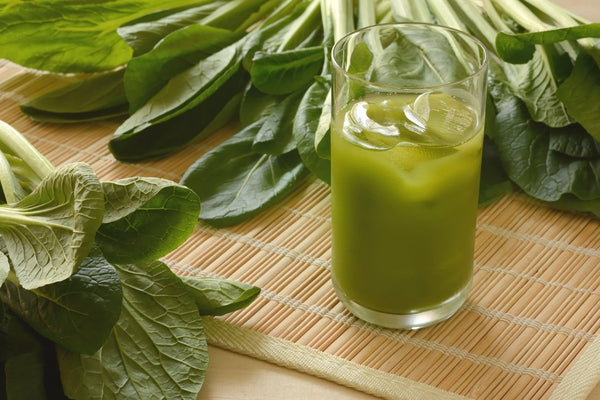
Jump to:
Did you know that aojiru (Japanese green juice) was actually popular in Japan before it got big in the West? It was! But how did it go from discarded waste to health phenomenon? This article will talk about aojiru’s history, what’s in it, its health benefits and more. Let’s get into it!
What Is Aojiru?
Aojiru is Japanese green juice that is usually made of kale or barley leaf. It’s full of nutrients (vitamins, minerals, and fiber). Plus, it has those oh-so-desirable antioxidants. Also, it looks a bit like matcha in its powdered form. It’s not related to matcha, though (although you can occasionally find matcha and aojiru in the same drink).
Aojiru Ingredients: Anything Goes?

Although aojiru is often made with kale or barley grass, other ingredients are used, too. For example, a Japanese plant called ashitaba (translated as “tomorrow leaves”) and mulberry leaves are often used. Fruit can be added, too — it makes the green juice sweeter and adds some extra nutrients. All kinds of veggies are acceptable, really (like with Asahi’s 21 vegetable aojiru). So yeah, basically anything goes with Japanese green juice — as long as it’s plant-based.
Japan’s Green Juice Creation Story
Japanese people have been drinking aojiru for some time. It was created in the 1940s (although people have been drinking various leaf juices for longer than that all over the world). But back during World War II there was a doctor in Japan who was trying to find ways to keep his family fed and healthy — it was hard to find sources of nutrition at the time. He noticed that a lot of vegetable waste was being discarded as trash (including plant leaves and plant parts).
So, he got an idea: “I’m going to turn these into a juice and give them to my family!” That’s not a direct quote, but he did just that. And despite the taste, they noticed the health benefits. The doctor said that his son and wife both got seriously ill and recovered quickly — which was credited to the aojiru.
So the doctor started tinkering with the recipe a bit, word spread, and soon enough it was being sold commercially. The drink became popular and remains so to this very day.
Note: It has been said that this doctor (Dr. Niro Endo) never actually made a penny from aojiru — he just wanted people to be healthy.
Aojiru Benefits: Hype Or Hard Facts?

Japanese green juice has tons of health benefits. One of the reasons is that it contains an enzyme called superoxide dismutase (SOD). The National Library of Medicine lists more health benefits for SOD than can be included in this article (so check it out), but that enzyme isn’t the only healthy thing about aojiru. Here are some other things it can help with.
Note: This is not medical advice, so please consult a doctor if you have serious questions about the effectiveness of aojiru.
- Weight Loss - It’s said that aojiru can help to normalize metabolism, which results in shedding pounds. Goodbye diet pen?
- Immune System Boost - There has been research done that shows green juice actually boosts immunity — it’s published in the peer-reviewed “Nutrition Journal.”
- Anti-Aging - Well, if you really want to prevent (or reverse) aging you might need some kind of gene therapy (according to a recent report in Time). But, since that’s only available to mice right now, how about something we can actually use? Aojiru! They say it can reduce the effects of aging due to its antioxidants.
- Lowering Blood Pressure - Aojiru contains potassium, and — according to the CDC — potassium can lower your blood pressure. And if you want even more potassium, add some aojiru powder to your banana smoothie (recipe here)!
- Lowering Cholesterol - There is plenty of fiber in Japanese green juice, and fiber helps to reduce the absorption of cholesterol into the bloodstream — as per Mayo Clinic.
- Intestinal Health - Also because of the fiber, it’s been said to improve intestinal health and even relieve constipation. You can read more about the other benefits of fiber on Healthline.
- Swelling Reduction - This is also related to the antioxidants in aojiru.
What Does Aojiru Taste Like? Ask A Lawnmower

It tastes like eating freshly-mowed grass . . . well, maybe not exactly, but almost! The point of this drink is not the taste. Pretty much everyone agrees that it’s bitter. Some more generous people say that the flavor is similar to tea or matcha. Of course, even though it’s bitter, you can make it a lot more tasty depending on the brand you buy and what you add to it. Many people add fruits or fruit juice, honey or sugar to sweeten it. Want to make aojiru at home? You can also do so with our recipe! If you don't have time to make fresh aojiru, you can also just mix the powder into pretty much anything you eat or drink (check out the recipes mentioned in this article for some interesting ideas).
Cultural Significance of Aojiru in Japan: A Punishment?
This not-exactly-delicious (but very nutritious) drink is popular in Japan mainly for its health benefits. It’s pretty much seen as just another way to keep yourself as genki (energetic/healthy) as possible. Japanese people are looking for that just as much as the next person. So, aojiru doesn’t have any spooky spiritual significance or anything (although it does have that somewhat interesting history with the doctor creating it from trash — as mentioned earlier).
Oh! But, there is some interesting TV trivia about green juice in Japan. For example, there was a famous commercial with a slogan that basically said “This is disgusting! I’ll have one more.” Pretty accurate — and can’t find a link to it, sorry! Aojiru has also been used as a punishment on Japanese game shows. People who lost a challenge would have to drink it. It looks a lot like what they do in this Japanese batsu gemu (punishment game) on YouTube.
Western Green Juice vs Japanese Aojiru: Any “Juicy” Differences?
What is the difference between aojiru and Western green juice? Well, they are quite similar in many ways, but in the West people don’t always include aojiru ingredients (like barley leaf and kale). Japan tends to start with the basic aojiru ingredients and then adds things on top of that. Now, there are exceptions to every rule, and some Japanese people (and companies) make aojiru without any of the standard ingredients. So, yeah, aojiru and Western green juice are almost the same thing, except the Japanese version usually has barley or kale.
Where To Buy Aojiru
In the West, you can buy aojiru at certain supermarkets, health food stores and online (including right here at Japanese Taste). If you’re in Japan, you can find it at grocery stores, drug stores, convenience stores and even at the rare aojiru juice shop!
The Best Japanese Green Juice Brands

There are lots of aojiru brands to choose from. Each one varies in flavor, ingredients and health benefits. Here are a few to consider.
- Asahi Aojiru Green Juice - With 21 kinds of vegetables in it, how could you go wrong? This green juice is made from young barley leaves and has tons of vitamins — especially because Asahi uses a freeze drying technique to preserve its nutrients. There’s a bit of fruit juice in this one, too, which makes the flavor a bit sweeter.
- Yakult Watashi no Aojiru - This young barley grass powder aojiru is from Oita, Japan. The leaves are picked when they have the most nutritional value. In this one there are no sweeteners added.
- Yamamoto Kanpo Aojiru - Yamamoto has been the best-selling aojiru in Japanese drugstores. It’s made with very pure green barley sprout powder with no additives.
Other Ways To Use Aojiru

Well, there’s more than one way to skin a . . . barley leaf? Yeah, aojiru isn’t only a drink — you can actually use it in other foods, too! This is usually done by adding the powder form of aojiru to whatever you're preparing. Some people mix it with yogurt or add it to smoothies, too. Here are some interesting recipes to try.
- Fluffy Green Pancakes - Tired of boring old normal-colored pancakes? Did you love Dr. Suess’ Green Eggs and Ham? Then look no further! Turn those plain hotcakes green with this unusual aojiru flapjack recipe.
- Udon with Matcha and Aojiru - If you like Japanese noodles, how about trying this not-so-standard udon recipe. You’ll get tasty udon, extra nutrients, a shot of caffeine and the color green.
- Aojiru Steamed Buns - These aren’t just tasty — they’re cute! Make some from scratch and steam them yourself with this recipe by Sugi Bee Garden.
Why You Should Try Aojiru

Still not convinced you should give aojiru a try? Well, maybe this will help. First, just think about your health. Green juice can help you with weight loss, anti-aging and so much more (as mentioned earlier in this article). That’s why people in Japan drink it!
If you’re staying away because you’re worried it doesn’t taste good (and you would be kind of right), don’t let that stop you. You can add sweeteners to it or add the aojiru to other things (like juices, milk, yogurt, pasta, pastries, and more). See the recipes mentioned earlier in this article, as well.
Lastly, don’t forget the cool factor. You’re not just drinking “green juice,” you’re drinking Japanese green juice. Hope you try it!


0 comments